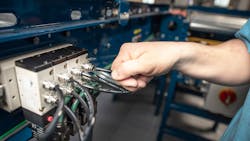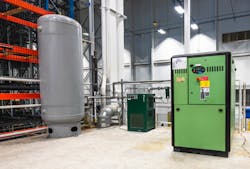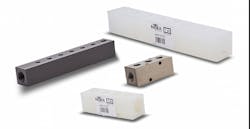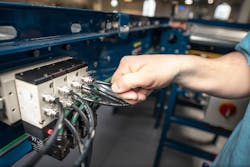Equipment and machine designers know that pneumatic energy is relatively inefficient compared to electrical energy. This drives up the operational energy costs when using pneumatics. However, pneumatic systems are still popular and widely employed for many industrial operations.
This is because when considered in the context of performance, installation costs and maintenance needs, pneumatics deliver good overall value and efficiency. Pneumatics are especially cost-effective and reliable as energy sources when used as a shared resource. Here’s why pneumatics is an important energy source for industrial applications, despite having a few downsides.
Efficiency Deficiency
Some estimates indicate that as little as 5 to 10% of the energy used to generate compressed air results in useful energy at end-use devices and equipment. The problem is that any time energy is converted from one form to another, there are always losses. Furthermore, there are more losses associated with transporting energy and, in the case of pneumatics, there are other losses possible anywhere in the system in the form of air pressure leaks.
Creating pneumatic energy generally requires two conversions and then storage. First, there is most likely a large electric motor converting electrical to mechanical energy. Second, the mechanical compressor converts mechanical energy to compressed air which is stored in a receiving tank for use downstream. More conversions mean more losses.
Compressed Air as an In-Plant Utility
Traditional energy utilities supplied to factories from external sources include electricity and natural gas. In addition, most industrial facilities generate some internal resources such as steam (converted from gas) and compressed air (converted from electricity). Compressed air is used so widely in industry that it is considered by many as a plant-generated utility.
Most industrial facilities route compressed air throughout their plants, often using oversized pipes ranging from two inches in diameter to much larger. Depending on the site and how the equipment using the compressed air is arranged, there can be a trunk line down the middle of the plant, a loop around the plant which can tapped as needed or several combinations of a trunk and loops.
The primary criteria for the main lines are that they supply enough pressurized air for any conceivable use, while being easily accessible so taps can be added as needed. Most main lines are relatively oversized because there is comparatively little cost in doing so.
For discussing energy supplies and use, it can be helpful to compare the situation to commuters going to work. Using the analogy of a city, we have the following comparisons:
- Each energy user (equipment, cylinder, motor) is like a commuter.
- Supplying an energy user with electricity is somewhat like giving a commuter a car to drive themselves to work.
- Supplying many closely located energy users by tapping a compressed air header is like having a host of commuters take the bus.
Energy users come in many types with varying needs. Electricity can be used in many cases, usually requiring motors along with associated gearboxes and mechanisms. Compressed air is popular for tools, machinery, paint spray booths and parts cleaning, to name a few uses.
Just as it makes economic and efficiency sense for commuters to take the bus when available, it also makes sense to use compressed to supply energy users to the greatest extent possible. As pneumatic supply systems approach 100% capacity—or full utilization—with more devices connected, efficiency improves.
To explain efficient utilization, assume in the commuting analogy that 48 people travel 10 miles to work, all working within walking distance of the arrival point. Each commuter drives a personal vehicle with fuel efficiencies of 18 mpg for an SUV, 25 mpg for a sedan and 50 mpg for a hybrid car. The average fuel economy for this fleet is then about 31 mpg per vehicle.
Crunching the numbers, this works out to 15.5 gallons of gas consumed per tip to work. If they carpool with four riding in each car, only 12 cars are needed, and they burn 3.9 gallons per trip. Taking it a step further, if all 48 people travel in one bus that gets 3.5 mpg, then each commuting direction only needs only 2.9 gallons per trip.
Of course, this is just an example and can be complicated by other factors such as whether the vehicles use gas, diesel and/or electricity. Everyone travelling in hybrid carpools might pencil out even better with regard to fuel use. Of course, 48 (or even just 12) vehicles may have higher maintenance costs than one bus, although the bus option must account for the cost of the driver and other support personnel.
The point of the above example is that as the number of people riding the bus increases, its efficiency in terms of fuel consumed per commuter also increases. It is the same with pneumatics; they become more cost-effective as more equipment uses it.
Streamlined Installation
The preceding sections addressed operating costs, comparing them to the fuel costs for transporting people. For the commuter analogy, the installation cost could be compared to the upfront purchase price of cars, busses and perhaps the roads.
For most comparable situations, pneumatic installations have much lower costs and are simpler than electrical installations. Electrical installations require physical space and electrical capacity on an available switchgear at the factory, which is often a limiting factor. A breaker will also need to be sized and installed in the switchgear, with wire sized by taking voltage drop into account, and conduit will need to be run.
All this requires some level of engineering, permitting from local authorities and even associated professional engineering reviews. The installation itself may be done by plant staff or subcontracted to licensed electricians to properly route conduit, pull conductors, terminate them and then test prior to installation. Electrical installations can quickly amount to a lot of paperwork, cost, time and red tape.
Installing a completely pneumatic machine, on the other hand, is much simpler. Internal maintenance staff simply needs to find the nearest compressed-air trunk or loop and then run a line large enough to handle the proper flow for the new equipment. The job is completed by installing a manual shutoff and other basic air-preparation devices. Some consideration is required to ensure enough available air capacity, but installation is straightforward as compared to providing electrical power to a machine.
Furthermore, it costs less to set up pneumatic hardware to do a task than to do the same with electrical motors and the associated hardware for the same job. Pneumatics often perform actions and generate forces that would be difficult to do with electrical devices. The best examples of this are linear motion, gripping and quarter-turn actions which are easily accomplished with relatively lightweight pneumatic cylinders which can generate significant force. For the same tasks, electrical motion can be more accurate but would typically require heavy motors and gearing.
If machinery needs to be reconfigured or moved, almost the entire electrical installation would need to be repeated; moving a pneumatic connection is a much simpler.
Simplified Maintenance
Maintenance staffing is another strong point in pneumatics’ favor. Good maintenance workers are hard to come by, and everyone in the maintenance staff typically has strong mechanical skills, making them well-suited for installing and maintaining pneumatic equipment. For many sites, on the other hand, it is far more rare for a licensed electrician or professional electrical engineer to be readily available.
Pneumatic parts operate reliably for a long time and are easily repaired or replaced. Maintaining pneumatic equipment is as simple as checking the machine periodically for wear, changing filters, and replacing worn-out or damaged components.
Maintaining electrical machines requires more specialty tools and training. Sometimes in-house maintenance staff can resolve electrical issues, but in many other cases, a machine’s vendor or outside technician is needed.
Compressed air generation inefficiencies are a negative factor for operational costs. However, by fully using pneumatics as a shared resource and taking advantage of installation and maintenance benefits, overall pneumatic efficiency can be cost-effective and make sense, particularly as compared to electrical alternatives.
Pneumatics can be improved by operating at pressures no higher than what is needed, properly drying and filtering the air for the best operation, and installing adequately sized lines. One critical point for efficiency is to remove any artificial demand, which means fixing leaks.
There is no such thing as a free lunch, but industrial plants and facilities choosing to operate as much machinery as possible with a properly maintained compressed air system can expect years of trouble-free operation.
Kevin Kakascik is a technical marketing engineer at AutomationDirect.



